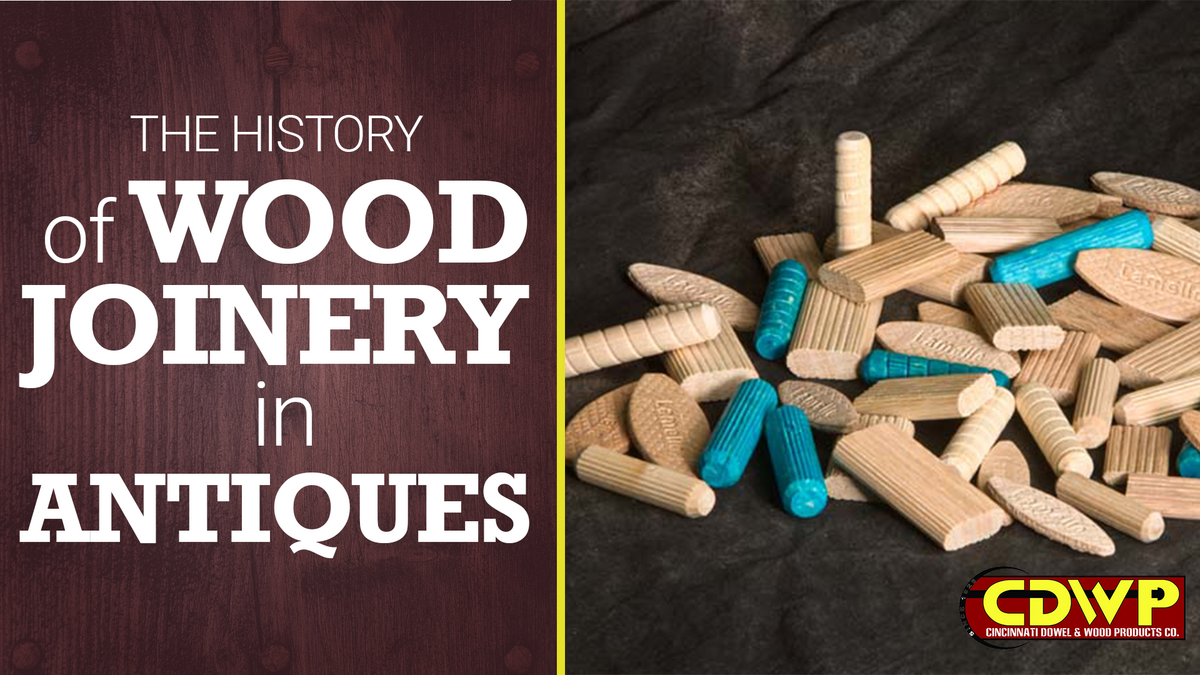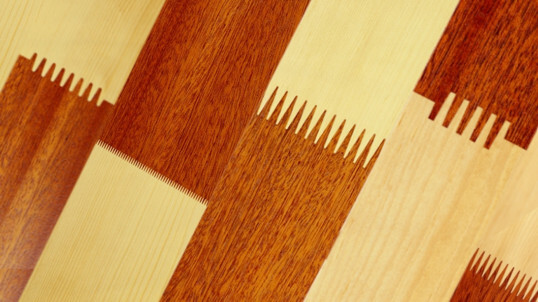The History of Wood Joinery in Antiques

When we think of furniture construction today, we too often get stuck in the process of assembling complex pieces using glue, nails, and other modern components.
However, for thousands of years, people have assembled wooden furniture without glue, staples, screws, or even nails. Antique furniture makers use joinery to make stunning pieces of furniture that have stood the test of time, and in some cases are sturdier and more attractive than modern pieces.
In this post, we’ll look at the different types of wood joinery used in antique furniture and their importance in furniture making. We’ll also briefly discuss dowel joints and their history.
The Early History of Wood Joinery
One of the oldest methods of joining pieces of wood together is pegged construction, which uses pegs (or dowels) to connect wood joints. The best example is timber framing, early barns and houses used “wood nails” to secure the roof and walls together. The process takes an end-bored dowel and matches it with a tenoned dowel to create a tight and reliable connection.
It's believed that the first pegged construction methods were used by ancient woodworkers as early as 3,000 BC in Egypt, but it wasn't until the 15th century that they became common among European furniture makers.
In the early days of furniture making, joinery was limited to simple methods like pegged construction. This method was used to construct everything from chairs and tables to chests and cabinets. In addition to being dependable, pegged construction allowed for pieces with complex shapes and angles that would have been impossible to achieve with nails or screws.
The word dowel is a modern word for an Old English word, "doule" which simply denotes a part of a wheel. Dowels had as many applications in ancient days as they do now. They were used for anything from plugs to shipbuilding.
One example from history is the use of wood dowels in the construction of Japanese sword handles. These deadly weapons relied on a long wooden handle to give the user ultimate control over the blade. This handle was composed on multiple wooden pieces, all of which were held together by a small wooden dowel. Remove this miniscule wood peg, and the entire handle would fall apart.
Hundreds of years later, the dowel would take on a new purpose, that of furniture making.
.png)
The 19th Century Revolution in Wood Furniture Making
By the 18th and 19th centuries, joinery was revolutionized with the introduction of new tools and materials. Dowel joints allowed for even more complex designs and angles than what was possible using pegged construction alone. They also allowed for easier assembly and disassembly of furniture pieces.
The Mortise and Tenon Joint
One of the most important wood joinery techniques developed during the 19th century was the mortise and tenon joint. This joint involves cutting a end-bore (or mortise) in one piece of wood and a protruding piece (or tenon) on the other piece of wood that fits snugly into the mortise. This joint is incredibly strong and has been used for centuries in furniture and building construction.
The Dovetail Joint
Another strong joint developed during the 19th century was the dovetail joint. This joint involves creating a series of interlocking trapezoidal "tails" on one piece of wood that fit into corresponding "pins" on the other piece of wood. This joint is commonly used in drawers and cabinets and is prized for its strength and durability.
The Finger Joint
The finger joint, also known as the box joint, is a technique in which two pieces of wood are joined by cutting alternating notches and protrusions that fit together like interlocking fingers. This joint is commonly used in box frames and is prized for its strength and simplicity.
The Glue Laminate
The glue laminate is a technique that involves laminating several thin pieces of wood together with glue to create a stronger and more stable piece of wood. This technique is commonly used in furniture and construction, particularly in curved or irregular shapes.
The Steam Bent Lamination
Steam bent lamination is a technique in which thin pieces of wood are bent into shape using steam and then laminated together with glue. This technique is commonly used in furniture and construction, particularly in chairs and other curved pieces, like acoustic guitars.

Wood Joinery in Today's World
Dowel joinery is still a useful technique in modern times and is often utilized in furniture construction, particularly in high-end and handmade pieces. It is also used in cabinetry and millwork. Dowel joinery is a popular alternative to traditional joinery methods such as mortise and tenon, as it allows for a quicker and more efficient construction process.
Let's look at some ways wood joinery is used in today's world.
1. Furniture Design
One of the most common modern applications of wood joinery is in furniture design. For example, a skilled woodworker might use dovetail joints to connect the legs of a chair to the seat, or a mortise and tenon joint to connect the rails of a table to the legs. These techniques not only create a beautiful, finished product but also add strength and durability to the furniture.
2. Timber Framing
Timber framing is a type of construction that uses large wooden beams to create the structure of a building. This technique has been used for centuries, and it's still popular today for creating barns, homes, and other structures. Wood joinery is an essential part of timber framing, as it allows builders to connect the beams together securely. Common joinery techniques used in timber framing include mortise and tenon joints and dovetail joints.
3. Flooring
Another modern application of wood joinery is flooring. To create beautiful, durable floors, builders often use tongue-and-groove joints to connect the individual boards together. These joints create a tight fit between the boards, which helps prevent gaps and warping over time.
4. Decorative Accents
Finally, wood joinery can be used to create decorative accents on furniture, cabinets, and other woodwork. For example, a woodworker might use a spline joint to connect two pieces of wood at a right angle, creating a decorative corner detail. Or they might use a finger joint to create a visually interesting pattern on the surface of a piece of furniture. Spiral grooved or fluted dowels are often used in this process.
Wood Dowels for You from Cincinnati Dowel
The history of joinery is long and fascinating. It is a process that has been used for hundreds of years in all parts of the world.
However, the quality of the dowel you use in your project matters. For that reason, you need high-quality dowel and wood components produced by Cincinnati Dowel.
At Cincinnati Dowel, we have produced the finest manufactured hardwood dowels, buttons, plugs, and other turnings since 1925. We have domestic species of wood including Red Oak, White Oak, Hard Maple, Soft Maple, Poplar, Beech, Hickory, Ash, Birch, Pine, Walnut, and Cherry. And we have exotic species of wood including African Mahogany, Genuine Mahogany, Sapele, Teak, Ipa, Brazilian Cherry (Jatoba), Ironwood (Ipe), Canary wood, Purpleheart, Yellow heart, Wenge & Many More.
For all your business's dowel and wood component needs in Cincinnati, the Midwest, and all over the United States, reach out to Cincinnati Dowel today!
For more information on wood dowels, follow Cincinnati Dowel on Facebook, LinkedIn, Pinterest, Instagram, and Twitter.
Also, if you are satisfied with your Cincinnati Dowel experience, leave us a five-star review here!


